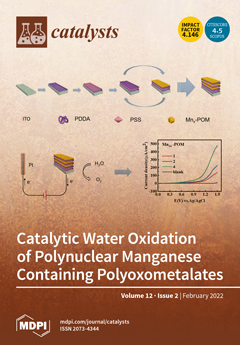Matured compost, derived from a mechanical and biological treatment (MBT) plant, was used as a precursor to produce catalysts through hydrothermal and thermal carbonization, HC and PC, respectively. HC and PC displayed suitable properties to act as catalysts in the catalytic wet peroxide
[...] Read more.
Matured compost, derived from a mechanical and biological treatment (MBT) plant, was used as a precursor to produce catalysts through hydrothermal and thermal carbonization, HC and PC, respectively. HC and PC displayed suitable properties to act as catalysts in the catalytic wet peroxide oxidation (CWPO) treatment of the highly polluted leachate waters generated in the same MBT plant (TOC
0 = 27 g L
−1; COD
0 = 60 g L
−1; BOD
5,0 = 23 g L
−1). The influence of catalyst loading and pH were studied, considering multiple additions of H
2O
2. The best experimental conditions found were T = 80 °C, pH
0 = 3.0, 7.2 g L
−1 of HC catalyst, 85.7 g L
−1 of H
2O
2, added in five batches in one-hour intervals between each addition. Under these experimental conditions, removals of 43%, 52%, 93%, 82%, 35%, 95% and 93% for the COD, TOC, BOD
5, aromaticity, chlorides, turbidity and color number (CN) were, respectively, observed. Ion exchange resins and coagulation–flocculation were studied as pretreatment options to reduce the complexity of the leachate waters and enhance the CWPO results. Both strategies resulted in higher mineralization and enhanced the consumption efficiency of H
2O
2 (η
H2O2). The sequential treatment using coagulation–flocculation and CWPO with PC catalyst showed the best results, achieving abatement of 94%, 70%, 98%, 93%, 31%, 96% and 95% for COD, TOC, BOD
5, aromaticity, chlorides, turbidity and CN, respectively.
Full article





